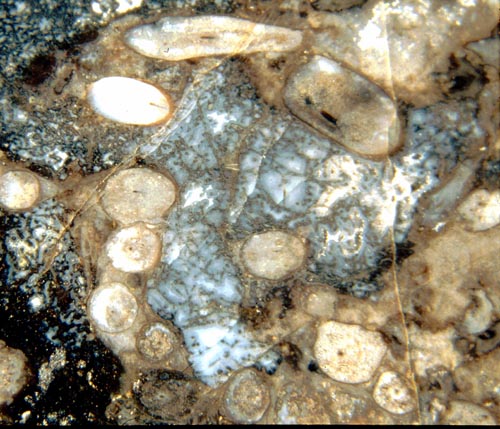Less-common fungus in the Rhynie chert
Silicification was so rapid at the Lower Devonian Rhynie chert location
that even quickly decaying structures like fungus hyphae were
preserved in large quantities (Fig.1), which is exceptional among
fossil-bearing sites. In order to judge the significance of fungi for
early terrestrial ecosystems one should be able to distinguish and
classify them. This is virtually impossible with hyphae alone.
Information on details beyond the plain hyphae is often not available
so that there are probably more species present in the chert than have
been firmly
established as such [1,2,3]. Any fungus-related structure with distinct
features, as the one in Fig. 2,
is worth being noticed.

Fig.1: Hyphae of some aquatic fungus grown
during an early stage of silicification in a
water-filled cavity which had been a gas bubble between Rhynia
shoots upset and inundated by flooding.

Fig.2: Fungus chlamydospore, diameter 0.5mm,
with small chlamydospores of an
intrusive fungus inside, 20-35Ám, within decayed
Rhynia;
same sample as Fig.1.
An object of same size and similar aspect as the one in Fig.2 had
been observed by Kidston
and Lang
[4] and interpreted as two fungi in
one: a big "resting-spore" (now usually called chlamydospore) of the
fungus Palaeomyces
gordonii var. major
filled with small chlamydospores of an unnamed intrusive fungus,
denoted there as Fungus No.14.
"Chlamydospore" is one of the not so well defined terms in
mycology, denoting usually thick-walled enclosures which a fungus may
occasionally bring forth, with the dual purpose of standing harsh
conditions and providing a way of asexual propagation. The
big type of chlamydospore filled with small ones is one of the rarer
sights in the
chert. There seems to be no easy way to find
out if the chlamydospores in Fig.2 are related to the hyphae in Fig.1.
It is worth mentioning that there is an unexpectedly close relation
between the most abundant and
thoroughly investigated fungus in the Rhynie chert, Glomites
rhyniensis [5], and extant Glomus
species, which are well-known for their arbuscular mycorrhizae.
H.-J. Weiss
2007, revised 2010
[1] T.N.
Taylor, E. Taylor: The Rhynie chert ecosystem: A
model for understanding fungal interactions,
in: Microbial Endophytes,
eds: Ch.W. Bacon,
J.F. White
Jr., New York 2000.
[2] T.N.
Taylor, S.D. Klavins, M. Krings, E.L. Taylor, H.
Kerp, H. Hass: Fungi from the Rhynie chert,
Trans. Roy. Soc. Edinburgh, Earth Sci.
94
(2004 for 2003), 457-73.
[3] H.
Kerp, H. Hass: De Onder-Devonische Rhynie Chert,
Grondboor & Hamer 58(2004),
33-50.
[4] R.
Kidston, W.H. Lang : On Old Red Sandstone
plants showing structure ...,
Part V, Trans. Roy. Soc. Edinburgh 52
(1921),
855-902.
[5] T.N.
Taylor, W. Remy, H. Hass, H. Kerp : Fossil arbuscular
mycorrhizae from the Early Devonian,
Mycologia 87(1995), 560-573.
 |
 |
19 |





